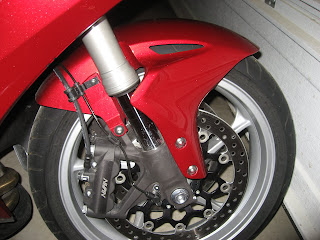There's a lot going on in that big goofy goiter hanging off the side of the VFR. To meet noise emissions testing a bike like this needs a quiet muffler. A quiet muffler is a restrictive muffler and a a restrictive muffler restricts performance. So they defeat the noise testing by fitting a muffler that is quiet within the testing range only (usually up to 50% of max RPM... 5000rpm in this case) The way they do this on the VFR is by using dual exhaust outlets. There is the small outlet on the bottom, no more than 2cm in diameter that exhaust gasses flow through below 5500RPM. Then there is a larger upper outlet that allows more exhaust volume to flow above 5500RPM. The flow is controlled by a "flapper" valve that is opened up using an electric servo motor, allowing exhaust to move through the larger outlet. Honda designed a sort of "failsafe" on the VFR1200 where they reversed the manner of operation. The default position of the exhaust flapper is the "open" position, and the servo motor actually holds it shut in the noise testing range. Due to this design, you can disable the system and the flapper will stay in the open position. The flapper is located in the end of the muffler, and the servo motor is located under the seat. They are connected by a cable. The easiest way to disable the system is to simply disconnect the cable. I went one better and removed the cable altogether. If would be nice to bin the servo motor as well, but it has a built-in feedback system to assure the ECU that the valve is in the correct position... if you remove the servo motor, you trip a fault code in the fuel injection and the bike goes into a "limp-home" mode with a flashing engine light.
Here's how it went:
Seat comes off:
Another example of quality... little rubber washers for the bolts that hold the cowl down
Side cowl comes off. The servo motor can be seen with the cable coming out the bottom.
This is the flapper in the closed position:
Remove the cable from the bell crank.
Now the flapper can be seen in the open position.
Just for the hell of it I decided to pull the heat shields and covers off the muffler to have a look.
The muffler swings away so the wheel can be removed. I took the cable out.
I also decided to remove the front reflectors. Before:
After. The reflectors are on brackets that help mount the fender. I had to replace them with some spare "tophat" collars. Looks a little cleaner now.
I started the bike and it definitely sounds better. More throaty and deep sounding. I'm looking forward to taking it for a ride and seeing if this helps improve the low-end torque.









Have you had any issues with check engine coming on doing this mod?
ReplyDeleteI only started and ran it for a few minutes but there was no light. The key is to rotate the servo motor back to its closed position.
ReplyDeleteDo you still have this mod in effect? or did you reverse it?
ReplyDeleteDid you get any low end torque improvment?
ReplyDeleteSkirolf
It feels like there is an improvement.
ReplyDeleteQuestion- I noticed you have changed to the Jardine, or similar slip on, after the cable removal. How long did you have the cable removal and were there any negative affects? Thanks.
ReplyDeleteI have the Leo Vince slip-on.
ReplyDeleteI ran the bike for a couple thousand Kms with the stock exhaust with the cable removed. No ill effects whatsoever. Be sure you don't disconnect the wiring to the servo motor though.... that will cause you some issues.
Thanks for the great pictures and advice. Cant wait to get home from work to do the mod to my VFR.
ReplyDeleteMy 2015 has a round reflector as OEM fitted. Now that's an update over the 2010 and well worth upgrading the to a newer bike just to get this upgrade.
ReplyDeletei strongly suggest not to do that! The valve improves low end torque by helping the scaveging effect of exhaust gases (it was initially patented by Yamaha).
ReplyDeleteThe sound test improvement is a secondary effect.